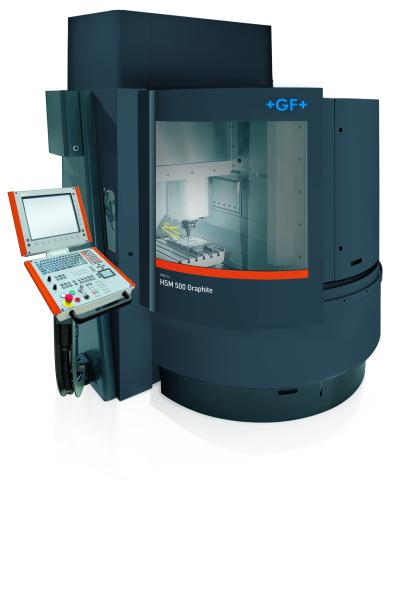
To meet the demanding mold and die machining needs of high-tech industries, GF Machining Solutions has unveiled the new Mikron HSM 500 Graphite high-speed mill. The system combines the features of a dedicated graphite machine with the flexibility of the company’s HSM 500 high-speed milling platform. Clad in black paint to denote its specialty, the machine sports an optimized Step-Tec 42,000-rpm spindle, a sophisticated exhaust system and the ability to quickly switch between wet and dry machining.
The flexibility of the HSM 500 Graphite ensures that shops can have an all-in-one high-speed milling solution that allows for wet applications while at the same time benefiting from a machine that specializes in graphite applications. Its high-dynamic drives, polymer concrete base and improved spindle allow the machine to hold tight tolerances, such as those required for advanced glass molds and other graphite parts.
“For most applications, the entire process has to be perfect, not just the machine,” said Dante Payva, project manager of GF Machining Solutions’ milling division. “Everything needs to be considered, from the overall shop environment and temperature to the precise measurement of the cutters and process speeds. Our smart machine modules and training programs make that easier than ever even as our machines become more sophisticated.”
To that end, the HSM 500 Graphite includes the Operator Support System for automating complex machine setting changes, Intelligent Thermal Control for warm-up time reductions as well as the highest possible accuracy and an Advanced Process System for on-the-fly control of spindle functions.
GF Machining Solutions has also designed the machine around its automation and die-sinking EDM lines to provide customers with a complete manufacturing solution, making it easy to pair the HSM 500 Graphite with such machines as a System 3R WorkPartner 1+ and an AgieCharmilles FORM P 250. The result of these innovations is a machine that can reliably and repeatedly provide the highest level of precision at speeds that allow for doubled production capacity and up to 200 percent more profit when compared to competing graphite mills.
Contact Details
Related Glossary Terms
- electrical-discharge machining ( EDM)
electrical-discharge machining ( EDM)
Process that vaporizes conductive materials by controlled application of pulsed electrical current that flows between a workpiece and electrode (tool) in a dielectric fluid. Permits machining shapes to tight accuracies without the internal stresses conventional machining often generates. Useful in diemaking.
- gang cutting ( milling)
gang cutting ( milling)
Machining with several cutters mounted on a single arbor, generally for simultaneous cutting.
- milling
milling
Machining operation in which metal or other material is removed by applying power to a rotating cutter. In vertical milling, the cutting tool is mounted vertically on the spindle. In horizontal milling, the cutting tool is mounted horizontally, either directly on the spindle or on an arbor. Horizontal milling is further broken down into conventional milling, where the cutter rotates opposite the direction of feed, or “up” into the workpiece; and climb milling, where the cutter rotates in the direction of feed, or “down” into the workpiece. Milling operations include plane or surface milling, endmilling, facemilling, angle milling, form milling and profiling.
- milling machine ( mill)
milling machine ( mill)
Runs endmills and arbor-mounted milling cutters. Features include a head with a spindle that drives the cutters; a column, knee and table that provide motion in the three Cartesian axes; and a base that supports the components and houses the cutting-fluid pump and reservoir. The work is mounted on the table and fed into the rotating cutter or endmill to accomplish the milling steps; vertical milling machines also feed endmills into the work by means of a spindle-mounted quill. Models range from small manual machines to big bed-type and duplex mills. All take one of three basic forms: vertical, horizontal or convertible horizontal/vertical. Vertical machines may be knee-type (the table is mounted on a knee that can be elevated) or bed-type (the table is securely supported and only moves horizontally). In general, horizontal machines are bigger and more powerful, while vertical machines are lighter but more versatile and easier to set up and operate.

